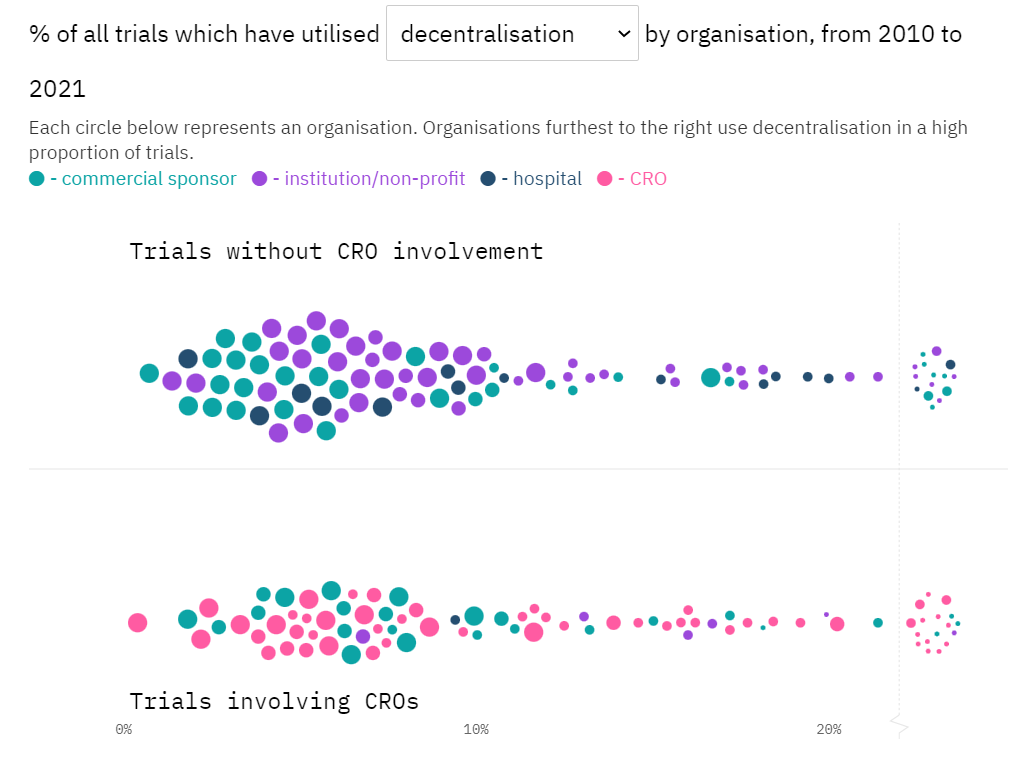Projected 28% Growth for Decentralized Trials in 2022
Need to know:
- A record number of around 1,300 trials with a decentralised and/or virtual component will likely initiate in 2022, representing a 28% increase from 2021.
- Mentions in trial protocols of oximeters, emails, and tablets also see significant growth.
- eDiaries and continuous glucose monitoring also among the most popular DCT approaches based on absolute numbers.
- Significant desire within the clinical trial industry to maintain the human touch, yet nontech DCT components slow on uptake.
While there’s been growing interest in decentralised clinical trials (DCT) over the years, the Covid-19 pandemic has made a seismic shift towards integration of these elements into studies. In fact, the number of drug trials with a virtual and/or decentralised element breached the 1,000-study milestone this year, a remarkable 50% increase compared with 2020.
And in 2022, DCT uptake is expected to gain further momentum. About 1,300 drug clinical trials with a virtual and/or decentralised component will start next year, representing a 28% increase from 2021, and a dramatic 93% boost from 2020, according to GlobalData analysis. These 2022 projections are based on mentions of more than 35 specific decentralisation and/or virtualisation elements in clinical registry protocols of trials involving a drug intervention.
Looking deeper into the data, the DCT elements with the largest growth in use this year compared to prepandemic times (2017–2019) are eConsent (460%), web-based questionnaires (448%), and oximeters (317%). Rounding up the top five are approaches related to emails (247%) and tablets (174%). Digital approaches like eConsents can streamline patient participation in clinical trials. Web-based questionnaires can aid with patient recruitment and can be designed for data collection to align with patient-centric endpoints.
While DCTs conjure up the idea of these trials being purely driven by digital, there are also nontechnology approaches such as home nursing and remote drug delivery. But the uptake of these components is trending to be much slower than technology-based ones.
Telemedicine popular in decentralised trials
Back in 2011, the most popular DCT approaches based on absolute numbers were telemedicine, eDiaries, continuous glucose monitoring, blood glucose monitoring, and activity trackers. This year, telemedicine, eDiaries, and continuous glucose are still in the top five, with mobile apps and smartphones also on the list. GlobalData forecasts the same five DCT elements this year will also top of the list in 2022.
 Telemedicine reduces the overall number of onsite visits, particularly in patients that are stable in their disease status, or do not require sample collection. However, telemedicine also has limitations as dermatologists found out during the pandemic, such as existing software not keeping at pace with image quality demands for accurate diagnosis.
Telemedicine reduces the overall number of onsite visits, particularly in patients that are stable in their disease status, or do not require sample collection. However, telemedicine also has limitations as dermatologists found out during the pandemic, such as existing software not keeping at pace with image quality demands for accurate diagnosis.
Between 2020 and 2021, mobile-based DCT components such as mobile apps and smartphones saw a large increase being integrated into trial designs, also due to lockdown measures. Mentions of text messages in protocols saw a 130% jump between 2020 and 2021.
Nontech components trending slowly
DCTs are not entirely tech-driven, with a handful of elements still featuring the human touch. Pharma executives and thought leaders in the clinical trial industry note that keeping the human element is important to maintain patient engagement. Nontech driven DCT elements include remote drug delivery and synthetic controls.
Yet, nontech-based decentralisation components, the most popular being home nursing, continue to make up a small share of all decentralised approaches. Between 2011 and 2021, home nursing was mentioned in an estimated 180 studies, compared with around 1,560 trials involving telemedicine during the same timeframe.
Home nursing continues to make up a small share of all decentralised approaches.
Even during the pandemic, the rate of nontech DCT did not see a significant increase. Among 2010 trials identified as including decentralised components, 4% had a nontech DCT element, which only increased by two points to 6% in 2019. Within the context of the pandemic, there was a four-point increase to 10% between 2020 and 2021. While these rates are not dramatic, there is a notable rise looking at absolute numbers. Specifically, there were 14 trial protocols mentioning home nursing in 2019, versus 35 in 2021.
The relatively slower uptake of nontech DCT elements could be due to the logistical and financial challenges involving hiring, training, and deploying clinical trial professionals to conduct assessments in patients’ homes. That said, throughout this year, Clinical Trials Arena spoke with DCT sponsors and CROs that said there will likely be renewed focus on conducting home visits more efficiently in the coming years.
Additional reporting by Reynald Castaneda
Read more on Clinical Trials Arena:
DCT Adoption Tracker: Who and what is at the crest of the trial decentralisation wave?
In an exclusive analysis, Clinical Trials Arena combed through drug trial public information to find out which decentralised approaches are making waves and talked to experts to put trends into context. Read more…




